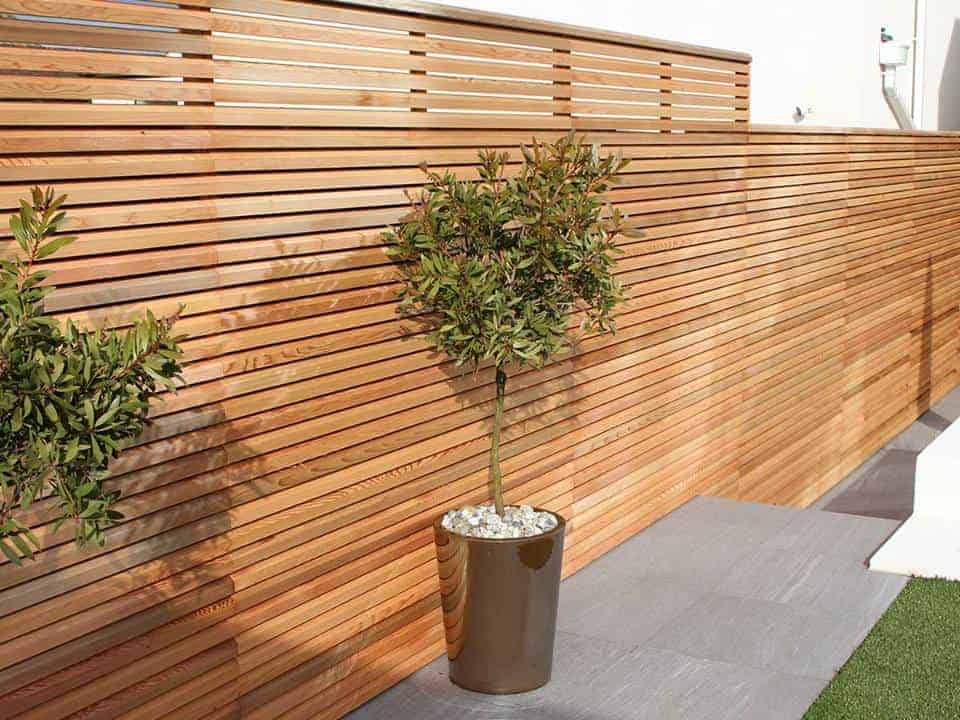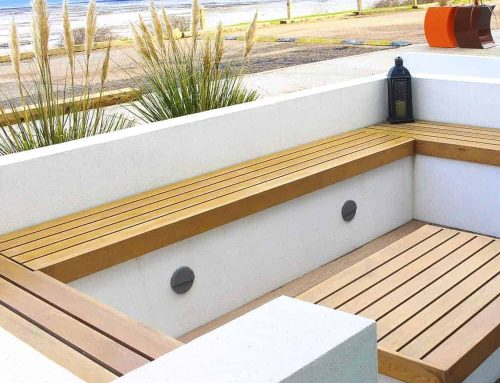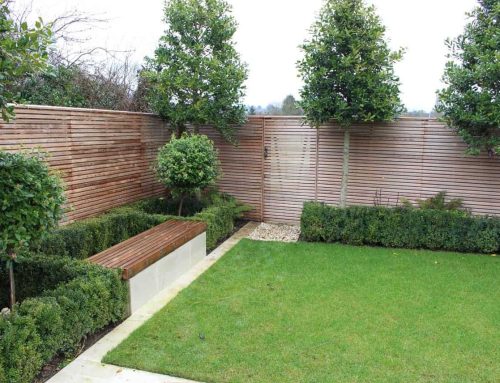In an ideal world, we would all have flat gardens and fencing on a slope would not be a problem. But unfortunately almost everyone needs to think about how to deal with a sloping fence, so this guide will hopefully help you to make sense of all the options.
To step or not to step, that is the question!
Garden fencing can either follow the ground level in a gradual fall or it can step down, it all depends on the type of panels you are using. Each of these fencing methods has both benefits and problems of which will now discuss in more detail.
Horizontal Slatted Fencing on a slope.
As you are reading this blog on the Contemporary Fencing website it probably means that you are interested in slatted style fencing, so with that in mind, we will start with horizontal slatted fencing on a sloped site.
So you love that funky slatted fencing but your garden is a hill what do you do.
Well, as mentioned earlier you can either step it or slope it.
The choice between the two again depends on the site conditions and what you want visually. Stepping slatted fencing is a bit more complicated than standard fencing; here are a few things to consider.
Most slatted fence panels are attached to the front of the fence post, when two panels are adjacent they join together at the centre of the face of the post. The post is then hidden behind and you have the lovely continuous slatted lines.
This works perfectly on flat and level sites. However, once you introduce steps in the fence you need to remember half of the post will become visible at the step down. To get over this problem we suggest that you use two posts next to each other at each step down, one at the higher height and one at the lower height. The problem is of course you need to buy more posts!
Another consideration when stepping slatted fencing is that your steps will need to be a size that suits the horizontal boards you are using. If your Horizontal slatted fence uses 44mm battens with a 7mm gap then your step will need to be a multiple of that size. Egg, 51mm or 102mm or 153mm.
How can you slope horizontal slatted fencing?
Well, luckily the clever chaps at Contemporary Fencing have come up with a new type of slatted fence panel that is designed to work on a slope.
This new Cequence sloping panel has Horizontal battens like all our other panels; the clever part is that the panel is cut to suit the size of the slope. They are simply screwed to the posts and hey presto all the hard work is done for you. Our revolutionary sloped fence panels are made bespoke to suit your individual garden slope.
The Cequence sloped panels can be used alongside standard Cequence panels so if you have a mixture of hilly areas and flat spots the fencing will flow around the garden perfectly.
Stepped Close board fencing
Stepped fencing is normally done by using standard sized fence panels of say 6ft x 6ft and then these will step down gradually as the garden slopes. The size of the steps and the number of steps in your fencing will depend on the size of the fall in your garden.
It is always best to try and work out how many and how big the steps in your fencing will be before starting work; this will ensure you get a neat job with equal sized steps.
Firstly, you need to know the overall height difference in the slope. (The difference between the highest and lowest point in the fence line) eg. 300mm
Then you need to know the number of panels you are using. This will depend on the length of the fence run and the size of your fence panels. Eg 12 fence panels
Now work out a suitable step size, in this case as the fall is 300mm we could have three equal steps of 100mm.
The next thing to do is to work out where the steps will be. If the slope is gradual its best to step down your fencing in equal blocks of panels. To have three steps in 12 panels you would need to have a 100mm step after every three panels.
The problem with stepped fencing.
Fence panels are square and so as the ground slopes away a gap can appear under your panel. So gravel boards must be used to fill this gap.
Stepped fencing does not work well with extremely sloped sites; if the steps become too large the height of the fencing can become low at the step down point causing privacy issues.
The stepping line of a fence is not particularly attractive; it does not blend nicely into a garden setting. Most stepped fences use concrete posts and boards; these again are not very attractive.
The benefits of stepped fencing
It is probably the cheapest way of fencing a slope, using concrete posts and concrete gravel boards enables easy installation of stepped panels.
You can use standard fence panels when stepping a fence you do not need to construct the fence panel on site so it is a lot faster to install.
Sloping fencing or racking close board fencing
Sloping fencing is generally built on site, there are four main elements. A post an arris rail and featheredge boards and a gravel board.
As these parts come separately it means that the fence can be built to suit the slope in your garden.
Arris rails fit between the fence posts horizontally, they can follow the slope in the garden, for a 6ft high fence there are normally 3 rails. The vertical feather edge boards are nailed into the horizontal arris rails. Using a string line to guide the top of the fence you can install the top of the feather edge boards on a gradual slope.
Final Thoughts…
Now we have looked at some ways to fence a garden that slopes, it time for you to decide the most important thing. Which type of fencing am I going to use?
For more information on Cequence fencing products and our New sloping panels please get in contact.
DB















